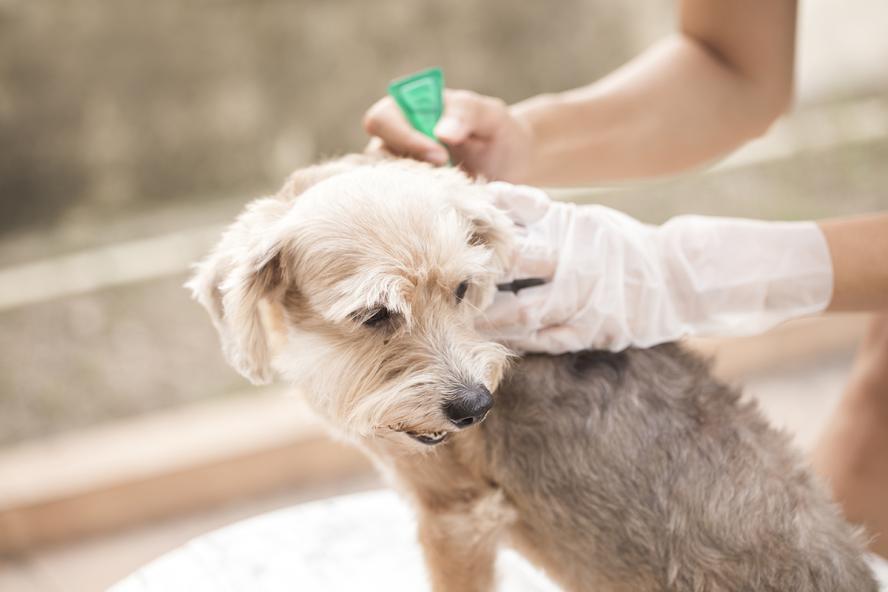-
About
- Leadership & Faculty
- News & Events
-
Academics
- Graduate
- Advanced Clinical Training
- Continuing Education
- Academic Departments
- Academic Offices
- Simulation Experiences
-
Student Life
- Offices
-
Research
-
Hospitals & Clinics
- Emergency Care
- Hospital Services
-
Community Outreach
- Volunteer
Is Winter Flea Prevention for Pets Necessary?
Ask the Expert

It is common knowledge that fleas are active from the spring through the fall, but should dog and cat owners be concerned about prevention during the winter months? An expert from Cummings School of Veterinary Medicine addresses this question.
Do fleas really survive during the winter?
The short answer is yes. Ctenocaphalides felis, the most common domestic flea of companion animals, undergoes four stages of development, starting from an egg to the adult flea. The pupa (pre-adult stage) is encased by a cocoon that allows it to survive in the home environment (carpet fibers, furniture, bedding) for weeks before finding a suitable host, giving the flea its hardy nature.1 While higher humidity and temperature favor the development of the adult flea, the rise of climate change, urban living, central indoor heating and dormancy of pupae have allowed fleas to become a year-round nuisance.2,3
What is the importance of flea preventatives if I don’t see fleas on my pet or in my home?
The adult is the only stage that requires a host on which to feed and reproduce. The other stages (egg, larvae, pupae) live in the environment. Furthermore, adult fleas found on an animal account for only 1–5% of all fleas and the remaining 95% are immature instars that remain hidden in the environment, so it is fitting that adult fleas represent the ‘tip of the iceberg’.4 Hence, finding just one adult flea or their feces (digested blood meal) on an animal is a sign of a flea infestation. Similarly, never spotting a flea on your pet does not mean they don’t have fleas. Frequent grooming often eliminates evidence of adult fleas on the animal.
Without regular flea prevention, your pet is at risk of flea-borne diseases, which include flea allergy dermatitis (one of the most common forms of allergies in dogs and cats), anemia, parasites, and infection. If you suspect your pet may have fleas, it is best to start them on regular flea preventatives, even when you cannot spot a flea.
What preventatives can I use for my pet?
There are many different flea preventative products with varying routes and frequency of administration, efficacy, and targets. One of the most important aspects of flea management is regular and consistent use. For instance, one-time treatment with a monthly preventative may not be active for the length of time needed to eliminate all fleas from a home, since many products kill only adults but not eggs, larvae, or pupae. Regular use ensures that all present and future fleas will eventually die. Another key strategy in eliminating fleas is to ensure all animals in a household are on preventative (including indoor cats). Otherwise, untreated animals will serve as a constant reservoir for flea reinfestation.
Some products that target fleas include the isoxazoline class of drugs (e.g. Bravecto®, Nexgard®, Credelio®, Advantage Multi®, and Revolution®). Many of these products target other ectoparasites too, such as ticks, ear mites, and scabies. Speak to your primary care veterinarian about the use and safety of these products before starting.
Dr. Tim Chan is a resident in dermatology at Cummings School of Veterinary Medicine at Tufts University.
References
- Rust MK, Dryden MW. The biology, ecology, and management of the cat flea [Internet]. Vol. 42, Annu. Rev. Entomol. 1997. Available from: www.annualreviews.org
- Clark F. Prevalence of the cat flea Ctenocephalides fells and oocyte development during autumn and winter in Leicester City, U.K. Med Vet Entomol. 1999 May;13(2):217–8.
- Iannino F, Sulli N, Maitino A, Pascucci I, Pampiglione G, Salucci S. Pulci di cane e gatto: Specie, biologia e malattie ad esse associate. Vol. 53, Veterinaria Italiana. Istituto Zooprofilattico dell’Abruzzo e del Molise; 2017. p. 277–88.
- Halos L, Beugnet F, Cardoso L, Farkas R, Franc M, Guillot J, et al. Flea control failure? Myths and realities. Vol. 30, Trends in Parasitology. Elsevier Ltd; 2014. p. 228–33.